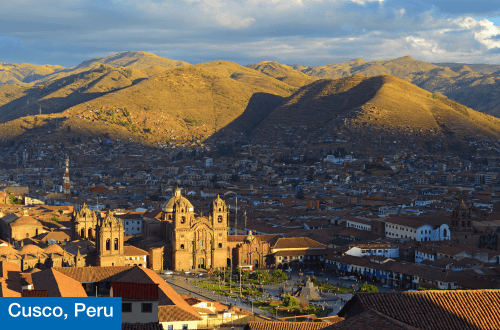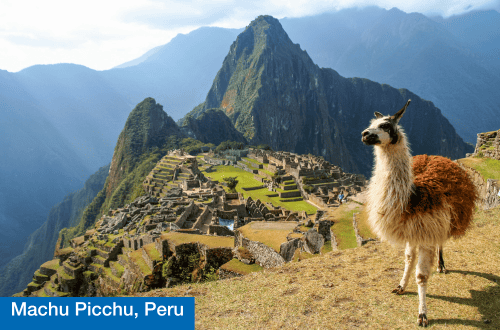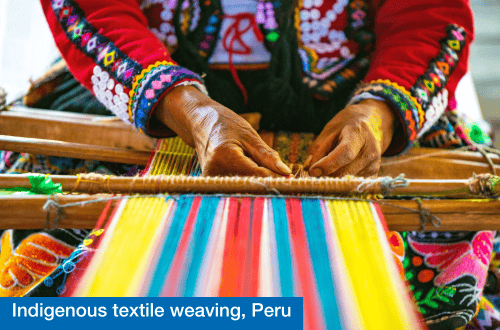


Machu Picchu is consistently named as one of the world’s ultimate bucket list destinations: a spectacular, fifteenth-century Incan citadel complex located high in the Peruvian Andes that truly has to be seen to be believed. Whether you’re planning a thrilling day trip or an epic four-day hike on the iconic Inca Trail, our guide to Machu Picchu is designed to cover everything you need to know before you go.

The city of Cusco serves as gateway to the Sacred Valley and Machu Picchu: there are regular flights from the Peruvian capital of Lima, which serves as a hub if you are travelling from elsewhere in South America. Alternatively, you may prefer to travel by long-distance bus so that you can experience the ever-changing landscape as you climb from sea level to around 3,400 metres.
Once in Cusco, you can catch a train to the town of Machu Picchu Pueblo (more commonly known as Aguas Calientes) – your personal travel manager can sort your train tickets in advance. The rail journey is simply spectacular, winding through narrow canyons as it follows the course of the Urubamba River, plus you can further upgrade your experience by opting to travel aboard the luxurious Belmond Hiram Bingham train. From the train station in Aguas Calientes, it’s a short bus ride (we recommend buying your bus ticket in advance) or two-hour walk along the zigzag route of the Hiram Bingham Highway to reach the entrance to Machu Picchu.
Alternatively, you can also catch a train from the town of Ollantaytambo, which is on the same route from Cusco and is renowned as a living example of an ancient Incan town.
If you’re planning to walk the Inca Trail, the most popular starting point (known as Kilometre 82) is close to Ollantaytambo. Alternatively, the Salkantay Trek is a longer, more challenging, and less crowded option if you are determined to reach Machu Picchu on foot. It starts in the village of Mollepata and ends at Aguas Calientes.
Starting from Kilometre 82, the Classic Inca Trail is a four-day, 43-kilometre journey through spectacular mountain terrain. It’s classed as ‘moderate’ terrain, but there is a lot of uphill and downhill hiking involved on your route to Machu Picchu, and the altitude adds an extra level of challenge to your adventure. At 4,215 metres above sea level, the highest point on the trail – the ominous-sounding Dead Woman’s Pass – is two thousand metres higher than Australia’s highest peak.
Although you don’t need elite levels of fitness to take on the Inca Trail, you do need to be comfortable walking at least 16 kilometres a day. In other words, being well prepared will ensure that you will enjoy your experience to the fullest. The good news is that you will only carry a day pack containing food, water and extra layers of clothing.
There are porters who will carry most of your gear between campsites, and trust us… they definitely deserve to be tipped generously!
There are two main seasons in the Peruvian Andes: the cooler dry season (April to October) and the warmer wet season (October to April). You are most likely to experience mild, dry conditions during the peak tourist season of June to August, but the trade-off for settled weather is larger crowds.
February is a no-go if you are planning to walk the Inca Trail, as the track is closed for maintenance. It’s also right in the middle of the wettest time of year, which means the site is frequently shrouded in misty clouds, and train services to Aguas Calientes are limited.
Ultimately, it comes down to what’s most important to you – if you’re looking for fewer crowds, opt for the quieter wet season months, but if you want the best chance of clear skies and dry trails, the high season (June to August) is ideal. May and September are a great compromise, offering settled weather, fewer tourists and more affordable prices.
Again, it comes down to priorities – there are few experiences on Earth to compete with the magic of watching the sun light up the surrounding mountain peaks, followed by the ancient stones of Machu Picchu itself. The gates open at 6am so you’ll need to be out of bed well before dawn to join the queue of people waiting to catch an early bus or start the walk from Aguas Calientes.
By midday, visitor numbers are at their peak, but from 2pm onwards, the crowds begin to thin out as people head back to Aguas Calientes or Cusco. Low mist often shrouds the ruins in the mornings, especially during the wet season, but later in the day, your patience is often rewarded with a gentle afternoon light that provides stunning conditions for photography.
Yes. Peru’s Ministry of Culture has implemented a permit system which allows them to manage the total number of daily visitors and the amount of time you can spend exploring the site. If you plan to hike Huayna Picchu or Machu Picchu Mountain during your visit, you will need additional tickets with specific entry times. In theory, it’s possible to buy your permits in Cusco or Aguas Calientes, but tickets can sell out months in advance so it’s a good idea to book well ahead.
Permits are also required to hike the Inca Trail; these are limited to a total of 500 per day and cover not just trekkers but also the support crew of guides, porters and cooks. Again, permits sell out very quickly (especially during the peak season), so we recommend booking at least six months in advance. Independent trekking is not permitted on the Inca Trail, but your personal travel manager can help you choose a licensed tour operator.

This UNESCO World Heritage site, which covers a total area of more than 32,000 hectares, is one of the most iconic and historically significant archaeological sites in the world. Thought to have been occupied from around 1420 to 1530 ACE, many of the site’s polished dry-stone structures have been restored over the last fifty years to provide an in-depth picture of Incan life.
The Sun Gate (Inti Punku) is the original entrance to Machu Picchu from the Inca Trail. It provides breathtaking panoramic views of the citadel and is a particularly popular spot from which to watch the sunrise. The Temple of the Sun, dedicated to the Inca sun god Inti, features an altar that is thought to have been used for sacrifices. The Room of the Three Windows is believed to hold astronomical significance – today, it is revered for its stunning views of the surrounding mountains. Other key sites within the central urban area include the Principal Temple, the Intihuatana Stone and the Royal Tomb.
The Residential Sector contains finely built houses of cut stone that were likely the homes of priests and nobility, as well as more modest buildings that housed the common people. The Industrial Sector consists of workshops and storage areas, while the surrounding Agricultural Sector is a vast collection of terraces that extend down the steep mountainside and are thought to have created microclimates and helped to prevent soil erosion.
The entire site is overlooked by two mountain peaks: Machu Picchu Mountain and the instantly recognisable Huayna Picchu. Both peaks can be accessed by permit holders via steep, narrow hiking paths and stone steps, and both offer panoramic views of Machu Picchu and the surrounding valleys from their summits.
Many visitors choose to travel directly from Cusco to Aguas Calientes, preferring its gentler altitude and easy access to Machu Picchu – especially if they are planning an early start. There’s a wide variety of accommodation options to choose from, ranging from affordable guesthouses and hostels to luxurious eco-resorts and boutique hotels.
It’s also a good idea to spend a night or two in Aguas Calientes at the conclusion of your Inca Trail adventure. The town’s name (which translates as Hot Waters) is a nod to its abundant natural thermal springs – we think a relaxing soak in a hot tub, surrounding by the natural beauty of forested mountain peaks, is the ideal tonic for tired limbs and aching muscles.
For a truly memorable experience, you can opt to stay at the spectacular Belmond Sanctuary Lodge, which, as the only accommodation located right next to Machu Picchu, offers exclusive access outside of regular visitor hours.

Machu Picchu Pueblo (aka Aguas Calientes) is at a lower altitude than Cusco and Machu Picchu (and much of the Inca Trail), making it the ideal location for acclimatising to the lower oxygen availability. Take it slowly and avoid over-exertion, especially on your first day, and ensure that you stay well hydrated. Coca tea, made by steeping the dried leaves of the coca plant, is effective in managing the symptoms of altitude sickness, which can include headaches, nausea, dizziness and fatigue. If you begin to experience more severe symptoms such as difficulty breathing or persistent vomiting, you should descend to a lower altitude immediately and/or seek urgent medical help.
The high altitude also means that you will be more susceptible to the effects of sun exposure, so be sure to pack a high SPF sunscreen, lip balm, hat and sunglasses. The weather can be unpredictable, so opt for lightweight layers (especially fine wool) that can be added or removed, or shop for beautiful, handmade alpaca wool clothing in traditional Incan designs.
Peru’s official currency is the Sol, which is subdivided into 100 céntimos. Although many tour operators, hotels and some restaurants will accept major credit cards or US dollars, it’s a good idea to carry some local currency for small purchases, tips and transactions.
It’s customary to tip your local guides and porters, and the standard rate is around USD 10-20 per day. There are ATMs (cajeros automáticos) in Aguas Calientes where you can withdraw Peruvian Soles, but it’s a good idea to have some cash available on arrival.
Machu Picchu’s mountainous location provides the perfect setting to disconnect from the digital world so you can enjoy its immense beauty without distractions. It’s a good idea to download offline maps of Aguas Calientes and Machu Picchu before you arrive so that you can navigate successfully without internet access.
If you’re longing to share your experience with your friends and family, you’ll find access to Wi-Fi in many of the hotels, cafes and bars in Aguas Calientes. However, if you need reliable internet access, you may need to wait until you’re back in Cusco, Ollantaytambo or other large cities.
Machu Picchu is considered one of the Seven New Wonders of the World, offering unique insights into the architectural genius, astronomical knowledge and cultural richness of Peru’s ancient Inca civilisation. To start planning your unforgettable journey to experience the “Lost City of the Incas”, contact your local personal travel manager.